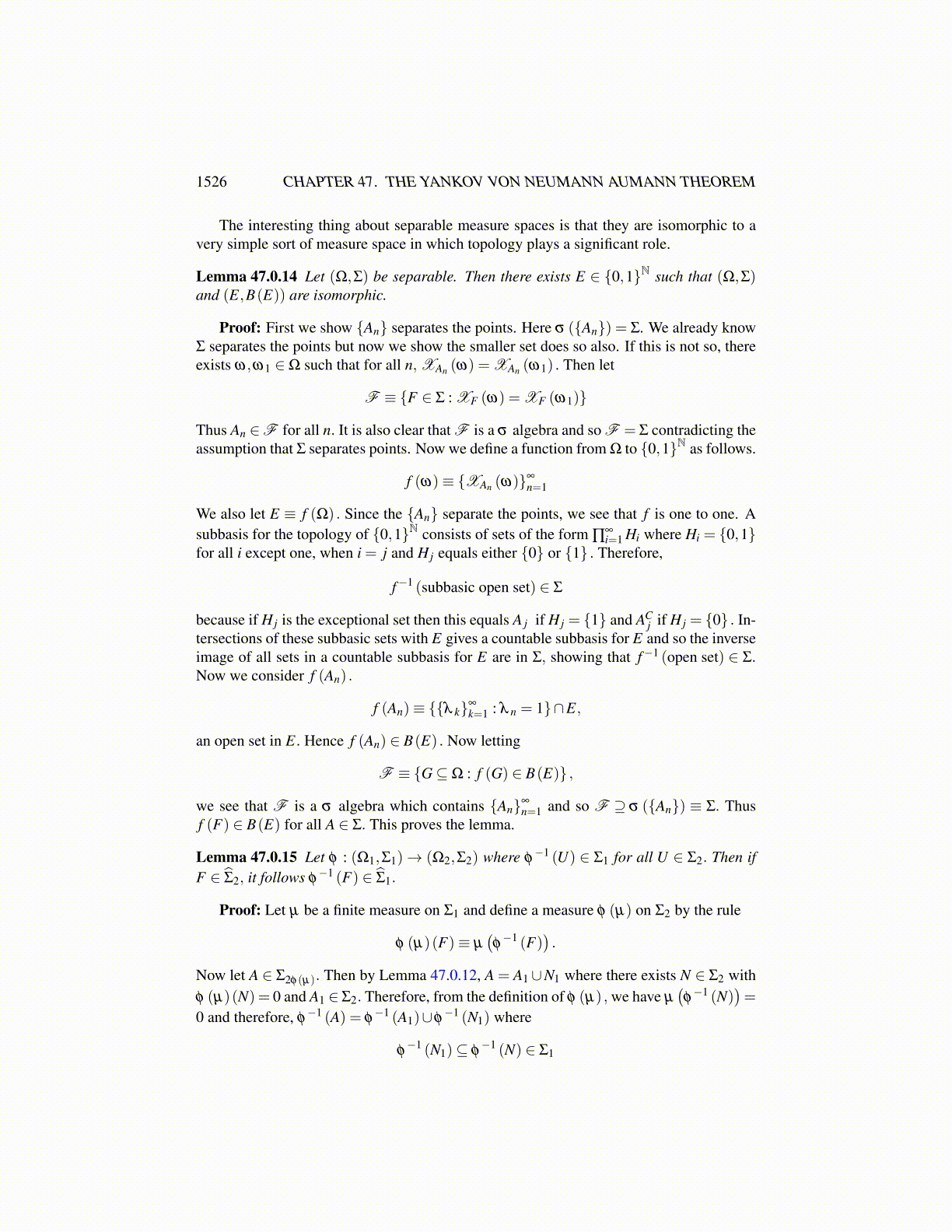
1526 CHAPTER 47. THE YANKOV VON NEUMANN AUMANN THEOREM
Now define a closed set,
C ≡ ∩∞k=1 f (E (m1,m2, · · · ,mk−1,mk)).
The sets f (E (m1,m2, · · · ,mk−1,mk)) are decreasing as k→ ∞ and so
µ∗ (C) = lim
k→∞µ∗(
f (E (m1,m2, · · · ,mk−1,mk)))≥ µ
∗ (A)− ε.
We wish to verify that C ⊆ A. If we can do this we will be done because C, being a closedset, is measurable and so
µ∗ (Ω) = µ
∗ (C)+µ∗ (Ω\C)≥ µ
∗ (A)− ε +µ∗ (Ω\A) .
Since ε is arbitrary, this will conclude the proof. Therefore, we only need to verify thatC ⊆ A.
What we know is that each f (E (m1,m2, · · · ,mk−1,mk)) is contained in A. We do notknow their closures are contained in A. We let m≡{mi}∞
i=1 where the mi are defined above.Then letting
K ≡{
n ∈ NN : ni ≤ mi for all i},
we see that K is a closed, hence complete subset of NN which is also totally bounded due tothe definition of the distance. Therefore, K is compact and so f (K) is also compact, henceclosed due to the assumption that Ω is a Hausdorff space and we know that f (K)⊆ A. Weverify that C = f (K) . We know f (K)⊆C. Suppose therefore, p∈C. From the definition ofC, we know there exists rk ∈ E (m1,m2, · · · ,mk−1,mk) such that d
(f(rk), p)< 1
k . Denote
by r̃k the element of NN which consists of modifying rk by taking all components after thekth equal to one. Thus r̃k ∈ K. Now
{r̃k}
is in a compact set and so taking a subsequence
we can have r̃k → r ∈ K. But from the metric on NN, it follows that ρ
(r̃k,rk
)< 1
2k−2 .
Therefore, rk→ r also and so f(rk)→ f (r) = p. Therefore, p ∈ f (K) and this proves the
theorem.Note we could have proved this under weaker assumptions. If we had assumed only
that every point has a countable basis (first axiom of countability) and Ω is Hausdorff, thesame argument would work. We will need the following definition.
Definition 47.0.10 Let F be a σ algebra of sets from Ω and let µ denote a finite measuredefined on F . We let Fµ denote the completion of F with respect to µ. Thus we let µ∗ bethe outer measure determined by µ and Fµ will be the σ algebra of µ∗ measurable subsetsof Ω. We also define F̂ by
F̂ ≡ ∩{Fµ : µ is a finite measure defined on F
}.
Also, if X is a topological space, we will denote by B(X) the Borel sets of X .
With this notation, we can give the following simple corollary of Theorem 47.0.9. Thisis really quite amazing.